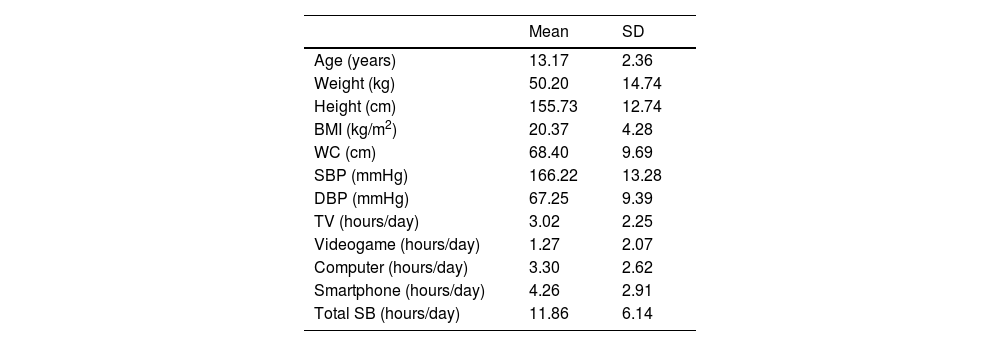Sedentary behavior (SB) has been related to cardiovascular risk factors (CVRF) such as high BMI, waist circumference (WC) and blood pressure (BP), including pediatric populations. However, it is still unclear whether the association between SB and CVRF could be domain dependent. Therefore, this study aimed to analyze the relationship between sedentary at different domains (time spent in TV, videogames, computer, smartphone) with CVRF in adolescents.
MethodsA sample of 1011 adolescents (10–17 years old; 55.1% girls) was assessed. The different BS domains were obtained through a questionnaire, as well as socioeconomic status, habitual physical activity, smoking and alcohol consumption. BMI was calculated by objectively measured height and body mass, WC was assessed at middle point between the last rib and iliac crest, and BP was assessed by a digital oscillometric device. The relationship between SB and CVRF was determined by quantile regression, adjusted for sex, age, socioeconomic status, physical activity, smoking and alcohol consumption.
ResultsElevated time in smartphone use was associated with higher median values of WC (β=1.88; 95%CI: (0.27; 3.49) and SBP (β=2.70; 95%CI: 0.35; 5.05). High total time spent in SB was associated with higher median values of BMI (β=0.68; 95%CI=(0.02; 1.35), WC (β=1.95; 95%=0.47; 3.42) and SBP (β=2.52; 95%CI: 0.37; 4.68).
ConclusionsSmartphone use and total SB time were related to higher CVRF in adolescents. Cardiovascular health promotion strategies should focus on reducing SB in pediatric populations, especially smartphone use.
El sedentarismo se ha relacionado con factores de riesgo cardiovascular (FRCV), como la obesidad y la hipertensión arterial (HTA) en las poblaciones pediátricas. Sin embargo, aún no está claro si la asociación entre el estilo de vida sedentario y la FRCV puede depender del dominio.
ObjetivoAnalizar la relación entre diferentes dominios del sedentarismo (tiempo dedicado a mirar televisión, videojuegos, computadora, teléfono celular) con los FRCV en los adolescentes.
MétodosSe evaluaron 1.011 adolescentes (10-17 años). Los diferentes dominios del sedentarismo se obtuvieron a través de un cuestionario. Los indicadores de obesidad se determinaron mediante el índice de masa corporal (IMC) y la circunferencia de cintura (CC). La presión arterial se evaluó mediante un dispositivo oscilométrico digital. La relación entre el comportamiento sedentario y loe FRCV se determinó mediante regresión cuantil, ajustada por sexo, edad, nivel socioeconómico, actividad física, tabaquismo y consumo de alcohol.
ResultadosEl tiempo de uso elevado del teléfono celular se asoció con valores medianos más altos de CC (β=1,88; IC 95%: 0,27-3,49) y presión arterial sistólica (β=2,70; IC 95%: 0,35-5,05). El comportamiento sedentario total se asoció con un mayor IMC (β=0,68; IC 95%: 0,02-1,35), CC (β=1,95; IC 95%: 0,47-3,42) y presión arterial sistólica (β=2,52; IC 95%: 0,37-4,68).
ConclusionesEl uso de teléfonos inteligentes y el tiempo total de comportamiento sedentario se relacionaron con un mayor FRCV en los adolescentes. Las estrategias de promoción de la salud cardiovascular deberían centrarse en reducir el comportamiento sedentario en las poblaciones pediátricas.








